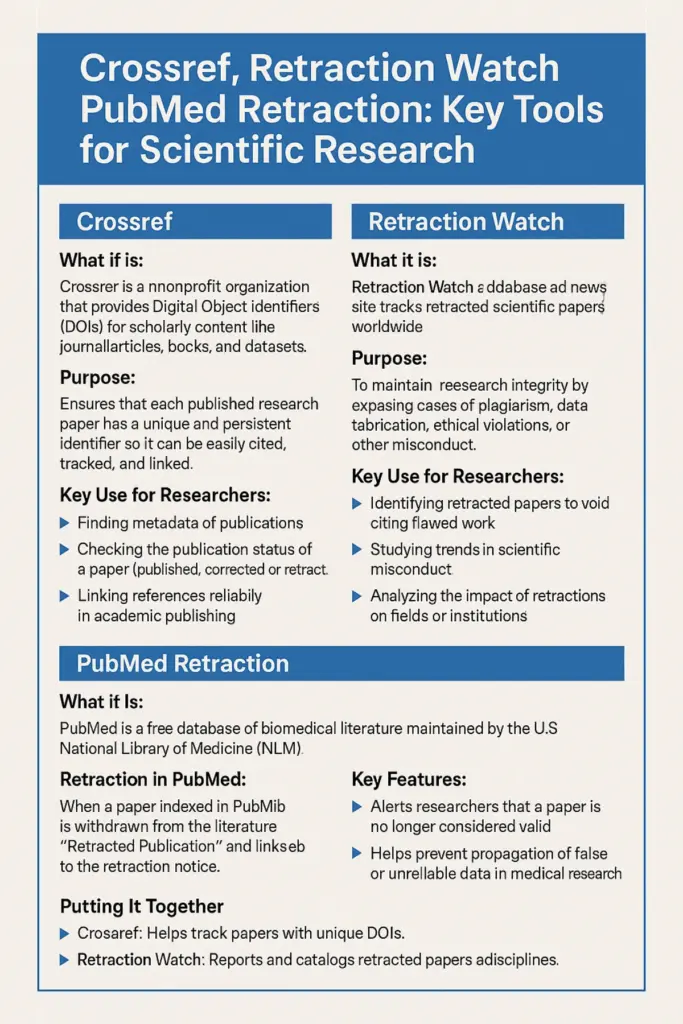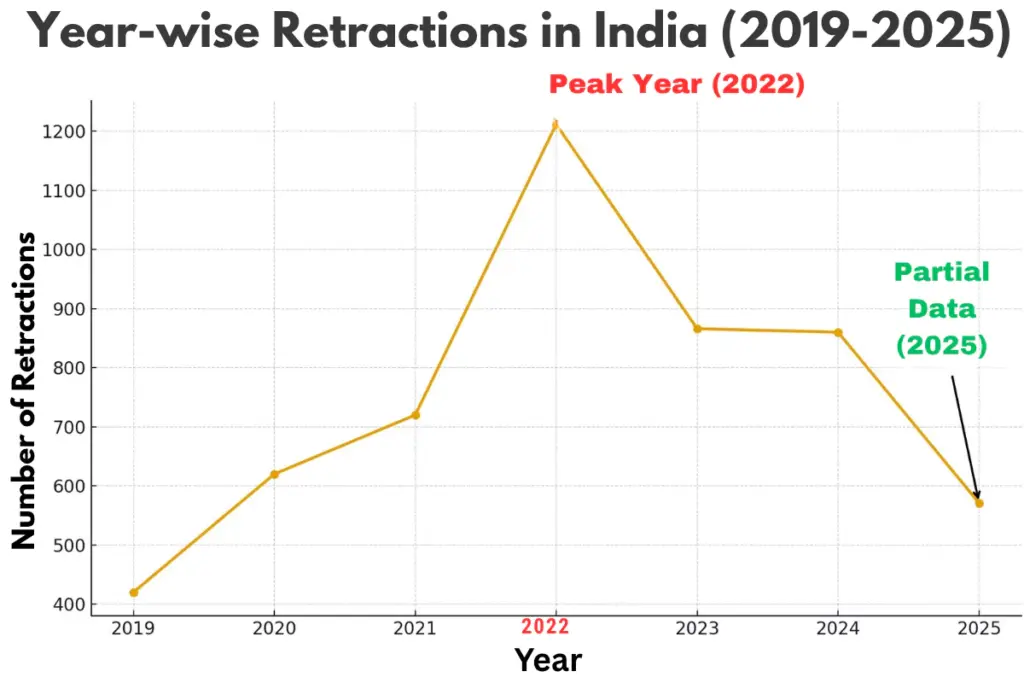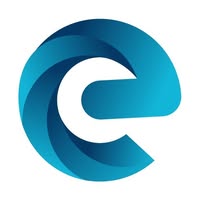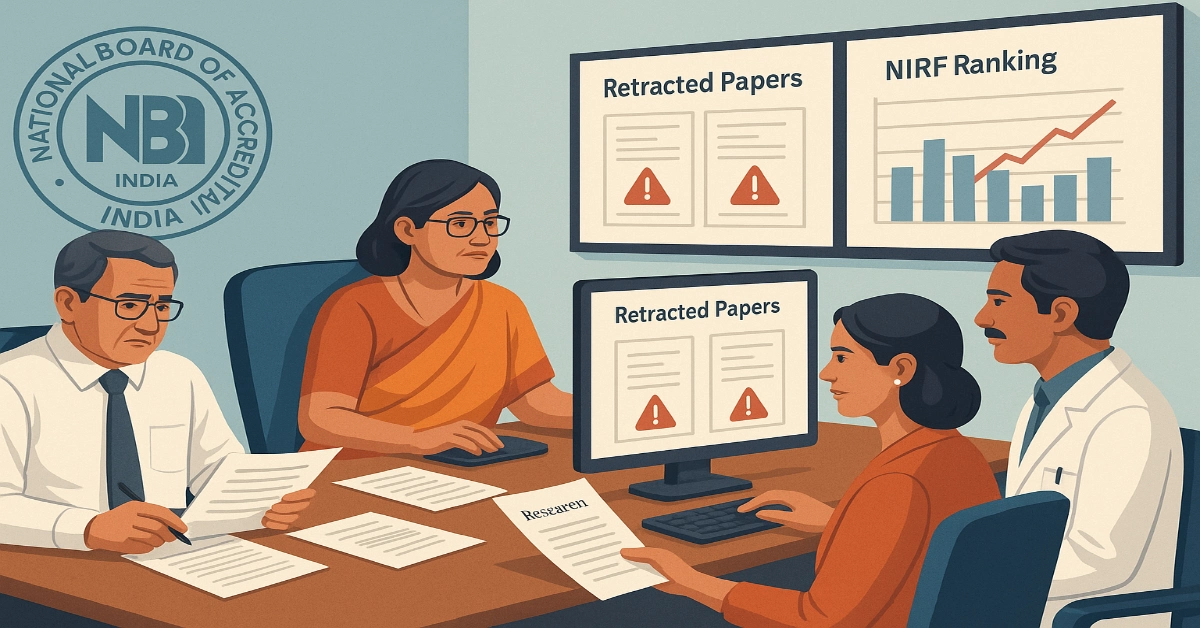NIRF to Penalise Retracted Research: The National Institutional Ranking Framework (NIRF), managed by the National Board of Accreditation (NBA), will take a necessary step to introduce negative marking to penalise retracted and poor-quality research. Announced alongside the release of the tenth edition of the NIRF, the move, confirmed by officials including NBA chairperson Anil Sahasrabudhe, is explicitly aimed at restoring credibility to university research metrics and deterring malpractice that has eroded trust in parts of India’s scholarly output.
| The National Board of Accreditation (NBA) is an autonomous body under the All India Council for Technical Education (AICTE), established in 1994 to assess and accredit technical and professional programs in India. |
This article explains what the change means, why it’s needed, how it might be implemented, and what consequences, intended and unintended, may follow for Indian universities, researchers, funders and students.
How NIRF Rankings Work
The NIRF evaluates institutions based on six key parameters:
NIRF evaluates colleges/universities based on five broad parameters, each with sub-parameters. NIRF Ranking Parameters are:
| Parameter | Weightage |
| Teaching, Learning & Resources (TLR) | 30% |
| Research and Professional Practice (RP) | 30% |
| Graduation Outcomes (GO) | 20% |
| Outreach and Inclusivity (OI) | 10% |
| Perception (PR) | 10% |
The RP parameter includes publications, citation quality, patents, intellectual property rights, sponsored research, and consultancy projects. A new category on sustainability will also be added, assessing institutions on Sustainable Development Goals 2030.
| The Sustainable Development Goals (SDGs) are a set of 17 global goals adopted by 193 United Nations member countries in 2015 as part of the 2030 Agenda for Sustainable Development. They aim to create a better, equitable, and sustainable future for people and the planet. |
NBA chairperson Anil Sahasrabudhe explained that retracted papers will lead to loss of marks for citations under RP, affecting overall NIRF rankings.
“In the coming years, we will name institutions and bar them from NIRF rankings for three to five years. This sends a strong message that unethical practices not only harm the institute’s reputation but also the country’s image,” Sahasrabudhe said.
Why NIRF to Penalise Retracted Research Paper?
Over the past decade, India’s research output has grown rapidly in absolute terms, but so have worries about research integrity.
A growing body of analyses and databases, including Retraction Watch, PubMed, Crossref and recent scientometric researchers’ studies, show that retractions and other integrity failures have risen sharply worldwide, and that India is among the countries with the highest counts of withdrawn life sciences papers.
| A scientometric researcher is someone who studies the quantitative aspects of science, research, and scholarly communication. Scientometrics is a field that applies statistical, mathematical, and computational methods to analyze research outputs, trends, and patterns in science. |
Those trends have been visible in Indian data too: institutional analyses and research monitoring projects report hundreds and, in some private tallies, thousands of retracted documents linked to Indian affiliations.
The scale of retractions and the clustering of retractions in certain institutions have prompted questions about how rankings reward output without penalising misconduct.
Officials told the press that “unless we give negative marks, people will not correct it.”
Until now, the NIRF rewarded publications and citations without reducing scores for retractions, an asymmetry that allowed institutions with high retraction counts to maintain inflated research metrics. The new rule intends to close that loophole.

Legal Scrutiny: The Madras High Court Intervention
The credibility of NIRF came under judicial scrutiny earlier this year when a Public Interest Litigation (PIL), filed in April 2025 before the Madras High Court, contested that NIRF rankings were based largely on self-reported data from institutions without independent verification, leading to potential manipulation and misrepresentation.
In response, the court issued an interim stay on the publication of the 2025 NIRF rankings, directing the Union Education Ministry and NBA to address the concerns raised.
Although the interim stay was later lifted, the case highlighted the need for a more robust and transparent evaluation process. The introduction of negative marking can be seen as a direct response to these legal challenges, aiming to restore credibility to the ranking system.
NBA Introduces Negative Marking
Anil Sahasrabudhe, chairman of the National Board of Accreditation (NBA), which oversees the NIRF rankings, stated that the framework will now include negative marks for the retraction of research papers by journals.
“For the first time, penalties are being formally incorporated into the ranking methodology to deter research malpractice and data misrepresentation. The negative marking system will be officially announced soon, with draft norms currently under preparation,” he told PTI.
He emphasized that institutions with high rates of retracted papers or citations from dubious sources would face penalties, thereby discouraging practices that compromise research quality.
This initiative aligns with the NBA’s broader mandate to ensure quality and accountability in higher education
India’s Research Retraction Scenario
India ranks second only to China in the number of retractions, according to the Retraction Watch Database, a global repository tracking retracted research papers. Retractions occur due to reasons such as plagiarism, data falsification, or manipulation of peer review.
- In China, over three papers per 1,000 publications are retracted.
- In India, two per 1,000 publications face retraction.
- In the US, the rate is less than one per 1,000.
An analysis by India Research Watch (IRW), based on Retraction Watch data, showed that from 1996 to 2024, India had 5,412 retractions, averaging 1.80 per 1,000 publications.
Breakdown of Retraction Reasons in India (1996–2024)
| Retraction Type | Number of Papers | Percentage (%) |
|---|---|---|
| Serious Misconduct (Plagiarism/Data Manip.) | 2,650 | 48% |
| Integrity Issues (Fake Peer Review, etc.) | 1,757 | 32% |
| Flawed Research / Honest Errors | 652 | 12% |
| Other / Unclassified | 353 | 8% |
| Total | 5,412 | 100% |

Expert Opinion on the New Penalty
Sanjay Tiwari, Medical University expert at RM Group of Education, welcomed the NBA’s decision, saying:
“Retractions are a symptom of a bigger malaise in the whole research ecosystem. University rankings reward quantity rather than quality. Penalising retractions will make universities act since it will directly affect their rankings.”
Mr Tiwari stressed the importance of accurate implementation, recommending the use of comprehensive databases like Retraction Watch or Scopus to ensure that penalties are applied fairly, acknowledging that not all retractions are due to misconduct.
| Scopus is one of the largest abstract and citation databases of peer-reviewed literature in the world. It is widely used by researchers, academic institutions, and publishers to track research publications, citations, and metrics. |
Strengthening the NIRF
While the introduction of negative marking is a step towards improving research integrity, experts suggest that further reforms are necessary. Recommendations include:
- Independent Audits: Regular independent audits of research outputs to ensure accuracy and authenticity.
- Clear Guidelines: Establishing clear guidelines for institutions on maintaining research integrity and reporting standards.
- Capacity Building: Providing training and resources to institutions to help them adhere to best practices in research and reporting.
By implementing these measures, NIRF can further strengthen its evaluation framework and contribute to the advancement of quality research in Indian higher education.
Potential Impact on Indian Universities
The implementation of negative marking is expected to have several implications for Indian universities:
- Enhanced Research Integrity: Institutions will be incentivized to uphold high standards of research to avoid penalties.
- Increased Transparency: The move towards stricter evaluation criteria may lead to more transparent reporting and auditing of research outputs.
- Reputation Management: Universities may invest more in ensuring the quality and authenticity of their research to maintain or improve their rankings.
However, there are also concerns about the potential challenges:
- Administrative Burden: Institutions may face increased administrative responsibilities to track and report research outputs accurately.
- Potential for Underreporting: Fear of penalties might lead some institutions to underreport research outputs, potentially affecting the overall assessment of research activity.
Read Also: NIRF Ranking 2025: Top 20 Medical Colleges In India
What “Negative Marking” in NIRF Could Look Like
The authorities have said draft norms are being prepared; the final design will matter enormously. Below are plausible, practical components NIRF could adopt:
Retraction-Adjusted Research Score
- Subtract a fixed or weighted penalty from an institution’s research metric for each retraction linked to its faculty/authors during a defined time window (for example, retractions within the previous 5 years).
- Weighting could reflect severity, full retraction for fraud vs. minor corrected errors. (Policy choice.)
Citation Filtering
- Exclude citations that originate in retracted or flagged papers from an institution’s citation counts.
- That avoids “tainted” citations artificially inflating impact.
- This is already technically feasible by linking to Retraction Watch / Crossref retraction flags.
Paper-Mill and Predatory Journal Flags
- Apply extra scrutiny to publications in outlets currently listed as hijacked or predatory
- Papers in such venues may be discounted or require additional verification.
Verification and Audit Trail
- Require institutions to maintain an auditable research register and make a sample of claimed publications/verifications accessible to NIRF auditors.
- Institutions that refuse audits could face harsher penalties.
Grace and Appeal Mechanism
- Implement a transparent appeals process to avoid unduly penalising researchers who made honest mistakes.
If designed well, these elements together could make negative marking precise, proportionate, and hard to game.
How Do Global Rankings Treat Retractions?
Global ranking systems (QS, Times Higher Education, Shanghai/ARWU) predominantly rely on publication and citation metrics, reputation surveys and internationalisation indicators.
None of the major global systems has historically integrated a systematic penalty for retracted papers into score calculations in the way NIRF is proposing.
That gap has been pointed out repeatedly by scientometric researchers: global rankings can reward volume and visibility without checking integrity, and that is one reason some observers welcome NIRF’s move as potentially pioneering.
How to Make Negative Marking Effective and Fair
To make the policy credible and minimise harm, the following design principles should be adopted:
- Transparency: Publish the exact formula, weightings, time windows and data sources used to detect retractions and flag tainted citations. Institutions should be able to calculate the effect on their own score.
- Data partnerships: Link NIRF scoring to authoritative retraction and correction sources (Crossref, Retraction Watch, PubMed retraction notices) to avoid false positives.
- Graduated penalties: Distinguish deliberate fraud from honest error; heavier penalties for proven misconduct, more lenient handling for honest mistakes with corrective actions.
- Capacity building: Provide funding and technical support to weaker institutions to set up research-integrity offices and training for students/faculty.
- Appeals and due process: Require a clear, timely appeals mechanism where institutions and authors can respond before penalties are final.
- Complementary incentives: Reward reproducible work, registered reports, data sharing and open peer review, so the system encourages good practice, not just punishes bad actors.
Significance of the Move
This decision reflects the NBA’s commitment to academic integrity. By factoring in retractions:
- Institutions will be discouraged from pushing low-quality research for rankings.
- Universities will be motivated to improve research ethics.
- The overall credibility of NIRF rankings will be strengthened.
Challenges Ahead
While the policy is welcomed, experts caution:
- Fair implementation is crucial to avoid penalising honest errors.
- Accurate and transparent tracking of retractions must be maintained.
- Institutions must be guided to enhance research quality rather than just avoid penalties.
Mr Tiwari added, “It’s not only the rankings that matter but also the research ecosystem. Penalising retractions should lead to systemic improvements in academic culture.”
The Big Picture: Credibility, Policy and Global Standing
The introduction of negative marking sends a strong signal that India intends to prioritise research quality and integrity, not just quantity.
If implemented transparently and carefully, it can restore trust in rankings and create positive ripple effects across hiring, funding and international collaborations. It can also prompt other ranking systems to think harder about integrity adjustments, positioning NIRF as an innovator in the global rankings ecosystem.
However, the measure alone won’t fix the root causes: perverse incentives in promotion, insufficient mentoring, a booming market for predatory publications, and under-resourced research offices at many institutions.
Negative marking is most effective when combined with systemic reforms, capacity building, funding for reproducible science, and stricter publishers’ standards.

